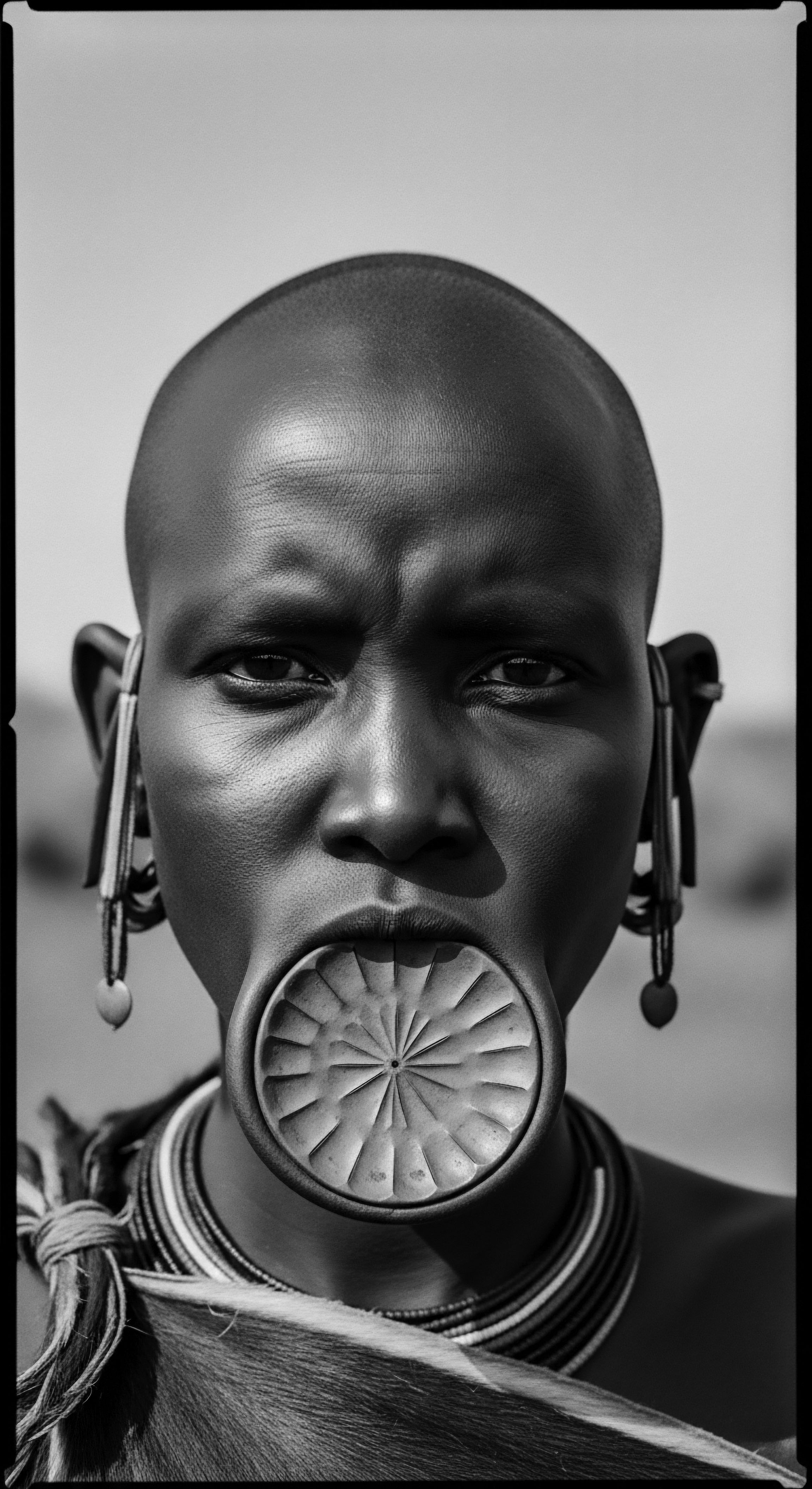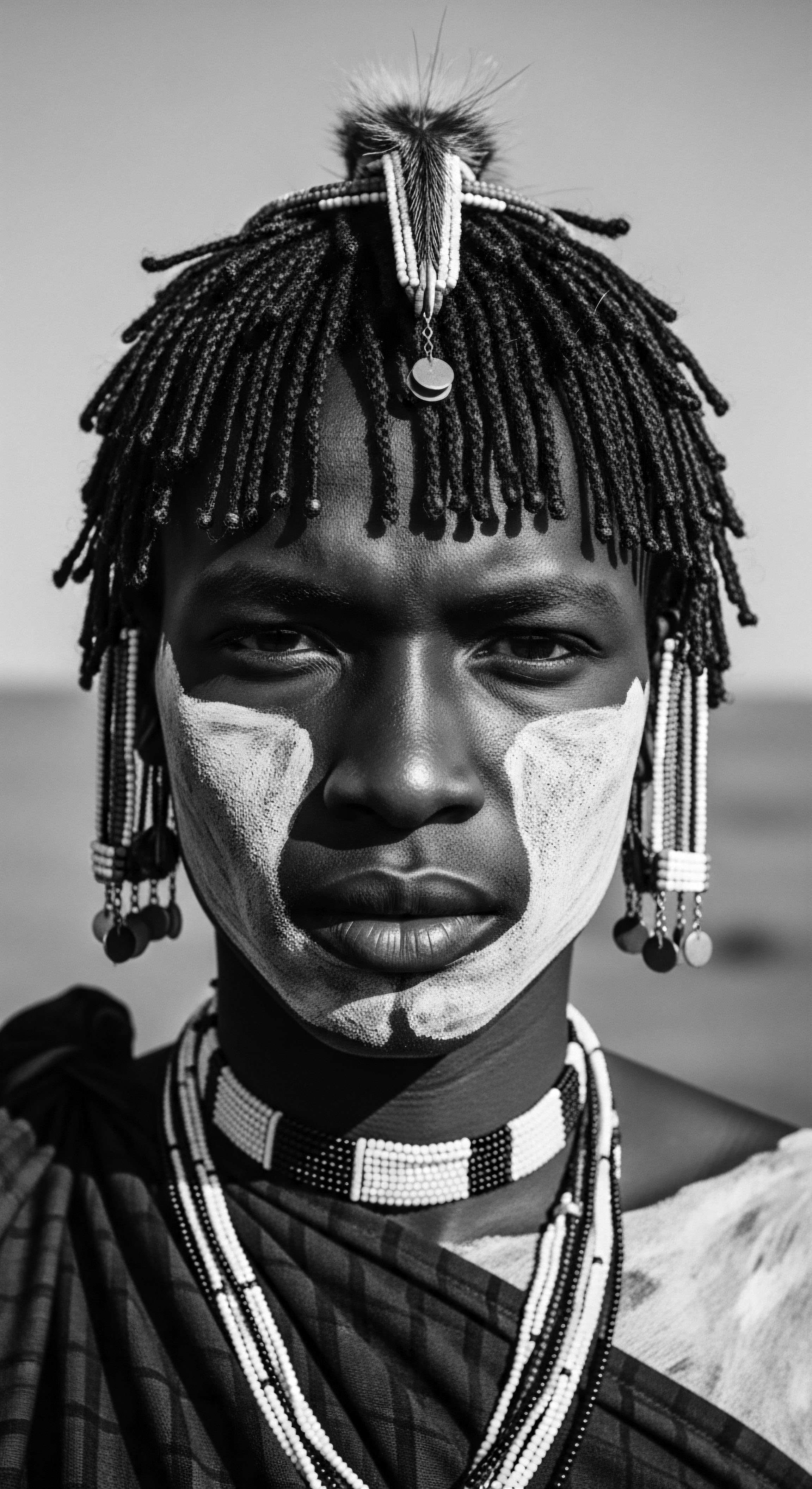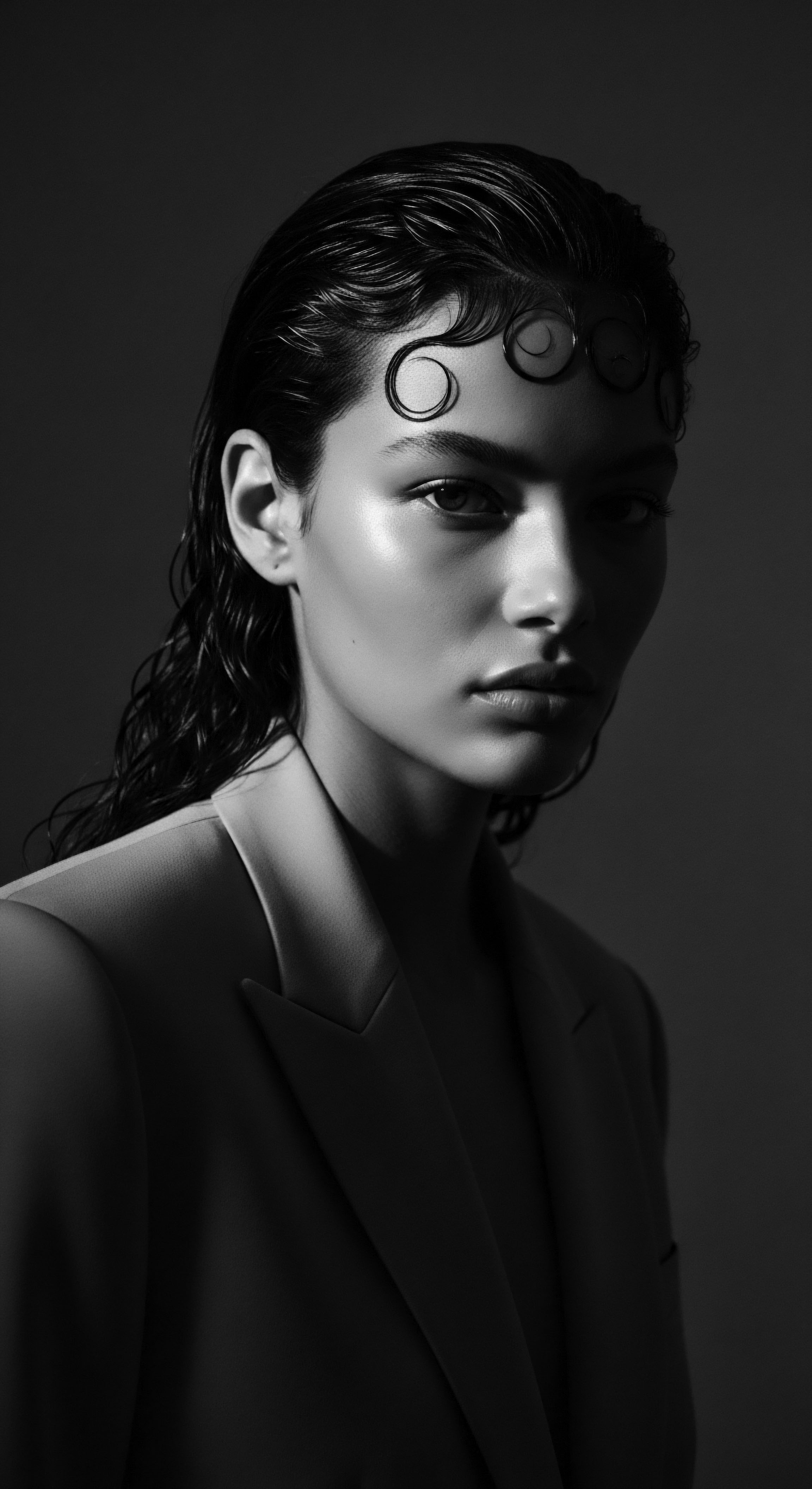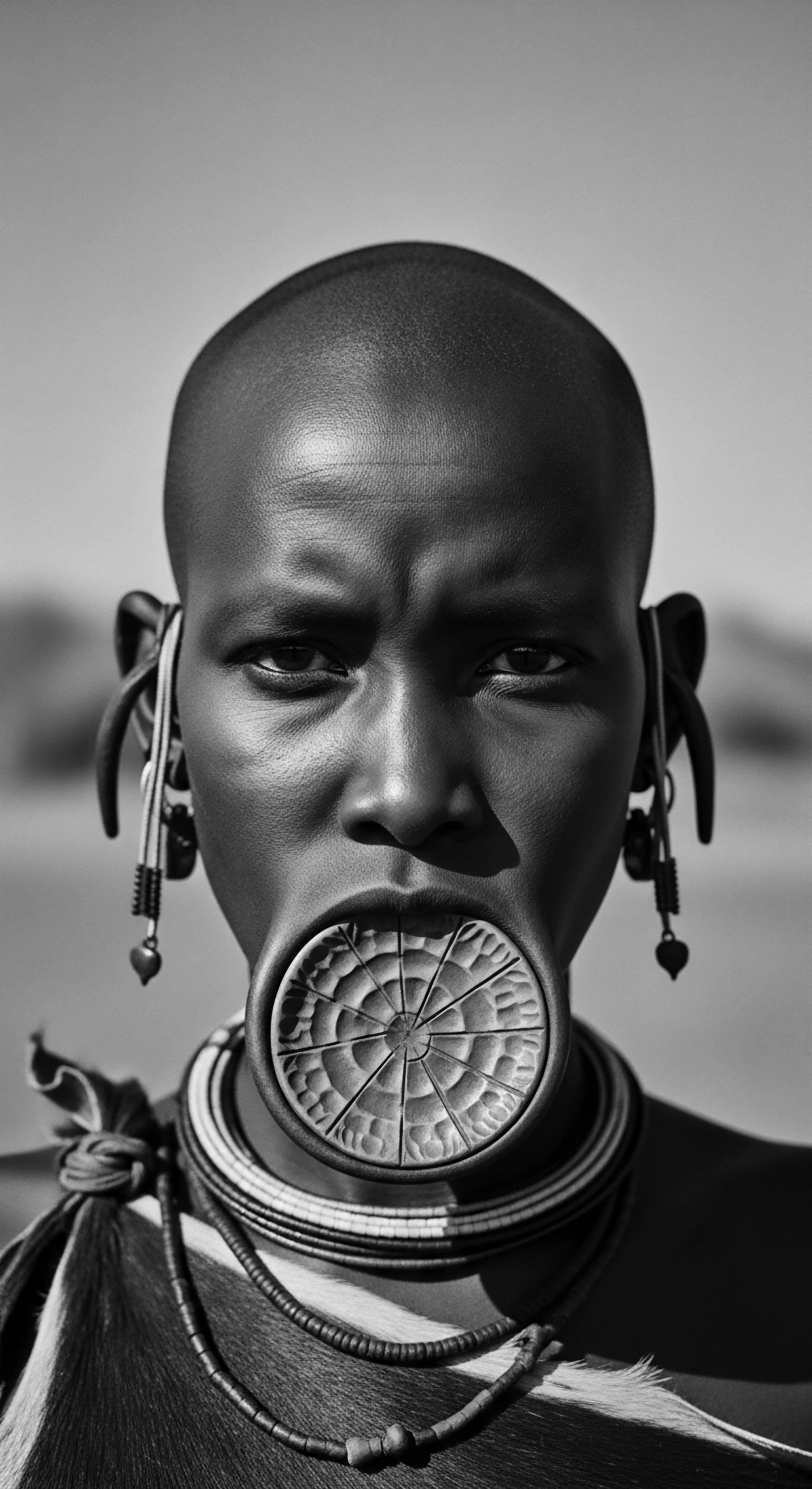
Fundamentals
The Egyptian Hair Rituals, within the vast archives of Roothea’s ‘living library,’ denote a rich tapestry of ancient practices dedicated to the care, adornment, and symbolic significance of hair in Kemet, the land we now call Egypt. This collection of traditions extended beyond mere aesthetics, serving as profound expressions of identity, social standing, spiritual devotion, and even a connection to the afterlife. For the ancient Egyptians, hair was a powerful medium, reflecting not only an individual’s place in society but also their aspirations for wellness and continuity. These rituals, spanning millennia, laid foundational understandings of hair care that resonate deeply with contemporary approaches to textured hair heritage.
The daily routines encompassed cleansing, moisturizing, and styling, often employing natural ingredients sourced from the fertile Nile Valley and surrounding regions. These practices aimed to maintain scalp health, encourage growth, and protect the hair from the harsh desert climate. The attention paid to hair was universal, reaching across all social strata, from the pharaohs and nobility to common citizens, though the opulence and complexity of the styles varied considerably. The understanding of Egyptian Hair Rituals begins with acknowledging their practical roots in hygiene and protection, evolving into elaborate expressions of personal and communal identity.

The Initial Care ❉ Cleansing and Conditioning
From the earliest dynasties, the pursuit of clean and healthy hair was a central aspect of daily life. The dry, arid climate of ancient Egypt necessitated diligent care to prevent dryness and breakage, particularly for hair with natural coils and curls. Ancient Egyptians utilized water for washing and incorporated various plant-based cleansers, though specific soap-like compounds remain subjects of ongoing study.
Following cleansing, the application of emollients was paramount. These were often rich, fatty substances designed to lubricate the hair shaft and scalp.
- Natural Oils ❉ Castor oil and almond oil were commonly used to keep hair smooth and moisturized, a practice that echoes modern textured hair care routines focused on sealing in hydration.
- Animal Fats ❉ Historical records and archaeological findings suggest the use of animal fats, such as those from hippopotamus, crocodile, and even snake, often blended with botanical extracts to create conditioning unguents.
- Beeswax and Resin ❉ These natural elements served as styling agents, providing hold and sheen to intricate coiffures and wigs. The durability of these substances ensured styles remained intact, even after death, for mummified individuals.

Early Adornment and Symbolism
Hair in ancient Egypt transcended its biological function, becoming a profound symbol of status, age, gender, and even religious belief. Decorative combs, some dating back to 3900 BCE, showcase intricate animal motifs, hinting at ritualistic connections. Wigs, a hallmark of ancient Egyptian style, were worn by all genders and classes as early as 3400 BCE, serving practical purposes like protection from lice and sun, alongside their aesthetic value. These elaborate hairpieces, often crafted from human hair, plant fibers, or even sheep’s wool, represented a significant investment and conveyed wealth and prestige.
Egyptian Hair Rituals represent an ancient and enduring commitment to hair care, where practical needs and profound symbolism intertwined.
The concept of hair as a marker of identity extended to specific styles. Children, for instance, often sported a distinctive “side-lock of youth,” a single braid or lock on one side of a otherwise shaved or cropped head, signifying their age and status before puberty. This particular style is a testament to the meticulous and intentional nature of ancient Egyptian hair practices.

Intermediate
The intermediate understanding of Egyptian Hair Rituals delves deeper into the sophisticated interplay of hygiene, social stratification, spiritual belief, and the innovative techniques employed by ancient Kemet’s inhabitants. Hair was not merely an appendage but a canvas for cultural expression, a protective shield against the elements, and a conduit for spiritual connection. The evolution of these practices over millennia reveals a society keenly attuned to the power and meaning held within each strand.

The Science of Ancient Care ❉ Ingredients and Their Purpose
The ancient Egyptians, through empirical observation and generations of accumulated wisdom, developed a sophisticated understanding of hair’s needs. Their “cosmetic palette” for hair was rich with natural ingredients, many of which find modern parallels in their efficacy for textured hair. The application of fatty substances, now understood as lipid-rich emollients, provided crucial moisture and elasticity to hair that, particularly in a dry climate, would be prone to brittleness.
A fascinating insight comes from the analysis of mummified hair. Studies, such as those conducted by Natalie McCreesh and her colleagues at the University of Manchester, revealed that many ancient Egyptian mummies, dating from Greco-Roman times, had their hair coated in a fat-based substance containing biological long-chain fatty acids like palmitic and stearic acid. This discovery suggests that these substances were not solely for post-mortem preservation but were likely daily styling products used to set intricate coiffures, even maintaining curls. This highlights an ancestral understanding of hair’s structural needs, where external lipids were applied to fortify and define the hair fiber, a concept central to contemporary textured hair care.
Ancient Egyptian hair practices offer compelling evidence of an early understanding of hair science, particularly the protective and styling benefits of natural fats and resins.
The Ebers Papyrus, a medical text dating back to 1550 BCE, contains various remedies for hair loss and to prevent graying, illustrating a concern for hair health that transcends mere vanity. While some of these remedies might appear unconventional by modern standards, they underscore a holistic approach to wellness where hair vitality was linked to overall well-being.

Hair as a Social and Spiritual Indicator
Hairstyles in ancient Egypt were highly codified, acting as visual cues for an individual’s place within the societal hierarchy. Elite men often wore elaborate wigs, sometimes above shoulder length, with distinctions in style signifying their rank. Women, regardless of social standing, generally maintained long hair, though elite women possessed an array of wigs and hairpieces for different occasions.
The symbolic weight of hair extended into the spiritual realm. Hair was seen as a source of vitality and power. The act of a king seizing enemies by their hair in depictions was not just a physical act of domination but a symbolic annihilation of their power.
Furthermore, hair played a role in funerary rituals; locks of hair were often deposited in tombs, either from the deceased or their relatives, to confer protective power in the afterlife. Priests, on the other hand, often shaved their heads to maintain ritual purity, demonstrating a different, yet equally profound, connection to the divine through hair’s absence.
Consider the following table, illustrating the intersection of social status and hair practices ❉
| Social Group Elite Men |
| Hair Practice/Style Elaborate wigs, often braided or curled, sometimes layered. |
| Associated Significance Wealth, prestige, authority, power to command. |
| Social Group Elite Women |
| Hair Practice/Style Long natural hair, diverse wigs, intricate plaits, curls. |
| Associated Significance Beauty, fertility, high social standing. |
| Social Group Children (Youth) |
| Hair Practice/Style Shaved head with a "side-lock of youth.", |
| Associated Significance Childhood, age marker, transition to adulthood. |
| Social Group Priests |
| Hair Practice/Style Shaven heads. |
| Associated Significance Ritual purity, devotion, spiritual connection. |
| Social Group Commoners |
| Hair Practice/Style Natural hair, simpler styles, less elaborate adornments. |
| Associated Significance Practicality, functional appearance, working class status. |
| Social Group These distinctions underscore how deeply hair practices were woven into the social fabric and spiritual life of ancient Egypt, reflecting a nuanced understanding of personal and collective identity. |

Academic
The Egyptian Hair Rituals, when viewed through an academic lens, represent a sophisticated body of ancestral knowledge and practice, fundamentally shaping the understanding of hair as a biological entity, a cultural artifact, and a spiritual conduit. This scholarly interpretation moves beyond superficial descriptions to dissect the underlying principles, the empirical evidence, and the enduring influence these traditions hold, particularly for the discourse surrounding textured hair heritage and Black/mixed hair experiences. The meaning of these rituals extends to a profound understanding of self, community, and the cosmic order, all expressed through the medium of hair.
The academic definition of Egyptian Hair Rituals posits them as a complex system of somatic and symbolic engagements with human hair, meticulously developed and transmitted across generations within ancient Kemet. This system encompassed a range of practices from daily hygiene and therapeutic applications to elaborate adornment and mortuary rites, all underpinned by a nuanced cultural semiotics where hair communicated social status, gender roles, life stages, and sacred affiliations. The elucidation of these rituals necessitates an interdisciplinary approach, drawing from archaeology, ethnobotany, bioarchaeology, and cultural anthropology to fully grasp their depth and sustained relevance.

Echoes from the Source ❉ Elemental Biology and Ancient Practices
At the core of Egyptian Hair Rituals lies an intuitive, perhaps empirically derived, grasp of hair biology. The climate of ancient Egypt, characterized by intense sun and arid conditions, presents significant challenges for hair health, especially for hair types prone to dryness and breakage, such as many forms of textured hair. The persistent use of fatty substances, resins, and oils—often identified through chemical analysis of archaeological remains—speaks to an ancient understanding of lipid replenishment for the hair shaft and scalp.
For instance, a study by McCreesh et al. (2011) published in the Journal of Archaeological Science meticulously analyzed hair samples from 18 mummies, revealing the widespread application of a fat-based product containing palmitic and stearic acids. This chemical signature indicates a deliberate and sophisticated formulation, functioning as an early form of hair gel or pomade. The continued preservation of intricate styles on mummified remains, such as the elaborately coiffed wig of Queen Tiye, further underscores the efficacy of these ancient preparations.
This is not merely anecdotal observation; it represents a tangible, scientific validation of ancestral practices. The fatty acids would have provided emollient properties, sealing the cuticle, reducing moisture loss, and offering a degree of environmental protection, all critical for maintaining the integrity of textured hair in challenging conditions.
The Papyrus Ebers and Hearst Papyrus, venerable medical texts from ancient Egypt, offer glimpses into the therapeutic dimensions of hair care. These documents detail remedies for hair loss, graying, and various scalp conditions, demonstrating a medicinal concern for hair health beyond mere cosmetic appeal. While some prescriptions involve ingredients that appear esoteric today, their presence signifies a systemic attempt to address hair ailments, connecting hair wellness to overall physiological balance. This ancient pharmacopoeia, often incorporating plant extracts, animal fats, and minerals, served as a precursor to modern trichology, underscoring the deep historical roots of holistic hair care.

The Composition of Ancient Unguents ❉ A Deeper Look
The formulations of ancient Egyptian hair preparations were not arbitrary. They often combined lipid bases with aromatic resins and plant extracts, creating products that simultaneously conditioned, styled, and scented the hair.
- Fatty Bases ❉ Animal Fats, such as beef fat or hippopotamus fat, provided the primary emollient foundation, delivering essential lipids to the hair and scalp. These fats, rich in saturated and unsaturated fatty acids, would have coated the hair shaft, imparting shine and reducing friction.
- Resins and Waxes ❉ Beeswax and Various Plant Resins were incorporated for their binding and styling properties, allowing for the creation and preservation of complex coiffures. Their hydrophobic nature would have also offered a protective barrier against humidity and environmental aggressors.
- Botanical Additives ❉ Almond Oil and Castor Oil were known for their conditioning benefits, likely contributing to hair’s softness and pliability. Henna, derived from the Lawsonia inermis plant, was widely used for its dyeing properties, particularly to mask graying hair, and likely offered protein-binding benefits, strengthening the hair shaft.
This nuanced approach to ingredient selection reflects a sophisticated empirical understanding of material properties and their effects on hair. The sustained use of these preparations across social strata and through funerary practices points to their perceived efficacy and cultural significance.

The Tender Thread ❉ Living Traditions of Care and Community
The Egyptian Hair Rituals were not solitary acts but often communal experiences, particularly for women. The time spent in hair dressing, whether styling natural hair or intricate wigs, fostered social bonding and the transmission of knowledge across generations. This echoes the enduring tradition of hair care as a communal activity within Black and mixed-race communities, where braiding circles and salon visits are sites of cultural exchange, storytelling, and mutual care. The meticulous braiding techniques, the use of extensions, and the art of wig-making in ancient Egypt directly connect to the ingenuity and artistry seen in African and diasporic hair traditions.
The ‘Nubian wig,’ a style characterized by short, bushy curls framing the face, is a particularly compelling example of cultural exchange and aesthetic appreciation across ancient African civilizations. Egyptologists propose that this style, which mimics the natural hair textures of Nubian peoples, was adopted by figures like Queen Nefertiti during the Amarna period. This adoption is not merely a fashion trend; it represents a recognition and valuing of diverse African hair aesthetics within the highest echelons of Egyptian society. This historical precedent challenges Eurocentric narratives of beauty and highlights the ancient roots of celebrating textured hair.
The historical adoption of Nubian-inspired hairstyles in ancient Egypt stands as a testament to the profound cultural interconnectedness and shared aesthetic appreciation of diverse African hair textures.
The continuity of these traditions is visible in contemporary African hair practices. Bantu knots, or Zulu knots, for example, share a direct lineage with ancient Kemetic styles, illustrating how specific techniques and their symbolic meanings have persisted through millennia. This unbroken chain of ancestral practices underscores the living nature of these rituals, demonstrating their resilience and adaptability across time and geography.

Hair as a Symbol of Resistance and Resilience
While the immediate context of ancient Egypt may not directly present narratives of “resistance” in the modern sense, the profound connection of hair to identity, power, and spiritual well-being lays a conceptual groundwork for understanding its later role in diasporic communities. For ancient Egyptians, the meticulous care and styling of hair, including the use of elaborate wigs and adornments, served as a powerful assertion of self and status in a highly structured society. This self-determination through appearance can be seen as an early form of agency.
The emphasis on maintaining hair health and aesthetic appeal, even in death, speaks to a deep cultural value placed on physical presentation and continuity. This ancestral valuing of hair as a part of the holistic self is a critical heritage point for Black and mixed-race individuals today, many of whom navigate contemporary beauty standards that historically marginalized textured hair. The Egyptian Hair Rituals provide a historical anchor, affirming the inherent beauty and significance of hair that defies European norms, connecting modern experiences of hair reclamation to an ancient legacy of self-worth.

The Unbound Helix ❉ Voicing Identity and Shaping Futures
The academic examination of Egyptian Hair Rituals offers a potent counter-narrative to colonial interpretations of African history and aesthetics. By foregrounding the sophistication of ancient Egyptian hair care and its connection to diverse African hair textures, Roothea’s ‘living library’ challenges prevailing biases and affirms the richness of textured hair heritage. The systematic analysis of archaeological finds, textual evidence, and iconographic representations provides concrete proof of an advanced understanding of hair, its care, and its profound cultural meanings.
Consider the case of hair analysis from mummies, which not only reveals the use of ancient “hair gel” but also hints at the hair types present. While specific genetic analysis for curl patterns is complex on ancient remains, the archaeological evidence of wigs designed to mimic short, curly hair (like the Nubian wig) strongly suggests a recognition and perhaps even idealization of such textures within Egyptian society. This directly addresses the heritage of textured hair, providing historical validation for its beauty and versatility.
The enduring legacy of these rituals is not merely historical curiosity; it provides a foundational understanding for contemporary hair wellness. The emphasis on natural ingredients, scalp health, and protective styling within ancient Egyptian practices resonates with modern holistic hair care movements. The understanding that hair is more than just protein filaments, but a living extension of identity and ancestral connection, finds its deep roots in these ancient Kemetian traditions.
This perspective empowers individuals to view their hair not just as a personal attribute but as a tangible link to a rich and sophisticated past. The Egyptian Hair Rituals offer a powerful reminder that the care and adornment of textured hair are not recent innovations but are deeply embedded in millennia of ancestral wisdom and cultural expression. This recognition can foster a sense of pride and continuity, shaping a future where textured hair is universally celebrated for its intrinsic beauty and profound heritage.

Reflection on the Heritage of Egyptian Hair Rituals
As we draw this exploration of Egyptian Hair Rituals to a close, a profound sense of continuity emerges, linking the vibrant past of Kemet to the present-day experiences of textured hair. The echoes from ancient riverbanks, where meticulous hands applied rich unguents and fashioned intricate coiffures, resonate deeply with the ‘Soul of a Strand’ ethos. This journey through time reveals that hair care in ancient Egypt was never a superficial pursuit; it was a deeply ingrained practice of self-reverence, a public declaration of status, and a sacred connection to the divine and the ancestral realm.
The wisdom of the ancient Egyptians, manifest in their understanding of natural ingredients and their ingenious styling techniques, serves as a powerful affirmation for those who cherish their textured hair heritage today. Their practices, whether through the crafting of elaborate wigs or the careful tending of natural locks, illustrate a society that recognized hair as a living, breathing part of identity. This historical foundation offers a robust counter-narrative to any lingering notions that textured hair is anything but a legacy of beauty, strength, and remarkable adaptability. The ancient Egyptians, through their rituals, invite us to see our hair as a continuous thread, connecting us to a rich and powerful past, a testament to enduring human ingenuity and the timeless pursuit of well-being.

References
- Cox, G. (1977). The British Museum Book of Ancient Egypt. British Museum Press.
- Fletcher, J. (1994). Ancient Egyptian Hair ❉ A Study of Hair and Hairstyles in Ancient Egypt from the Predynastic Period to the Roman Period. University of Manchester.
- Fletcher, J. (1998). Ancient Egyptian Hair and Hairdressing. British Museum Press.
- Kandil, H. A. (2018). Role of the Hair in Ancient Egypt. International Journal of Tourism and Hospitality Management, 1(1), 76-87.
- Marshall, A. (2025). The magic and power of hair in ancient Egypt. The Past.
- McCreesh, N. Gize, A. & David, A. R. (2011). Ancient Egyptian hair gel ❉ New insight into ancient Egyptian mummification procedures through chemical analysis. Journal of Archaeological Science, 38(11), 2975-2980.
- Robins, G. (2020). Hair, Gender, and Social Status in Ancient Egypt. JSTOR Daily.
- Tassie, G. J. (2009). The Social and Ritual Contextualisation of Ancient Egyptian Hair and Hairstyles from the Protodynastic to the End of the Old Kingdom. UCL Discovery.
- Watterson, B. (1991). Women in Ancient Egypt. St. Martin’s Press.
